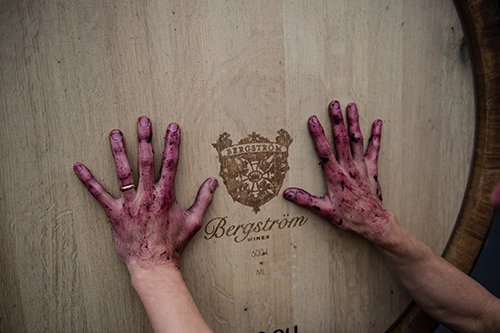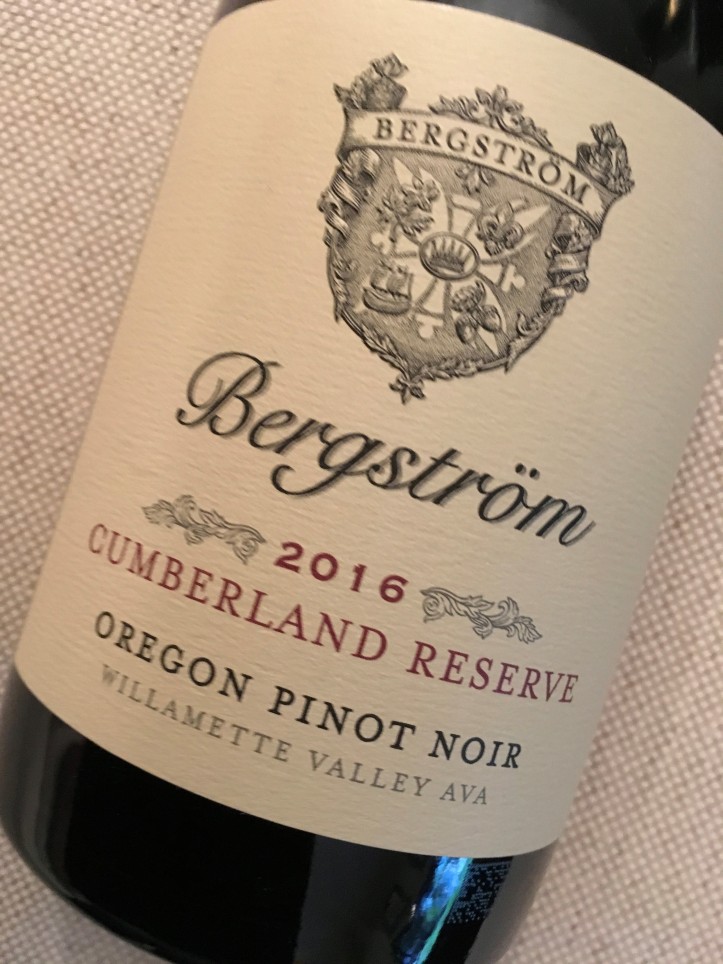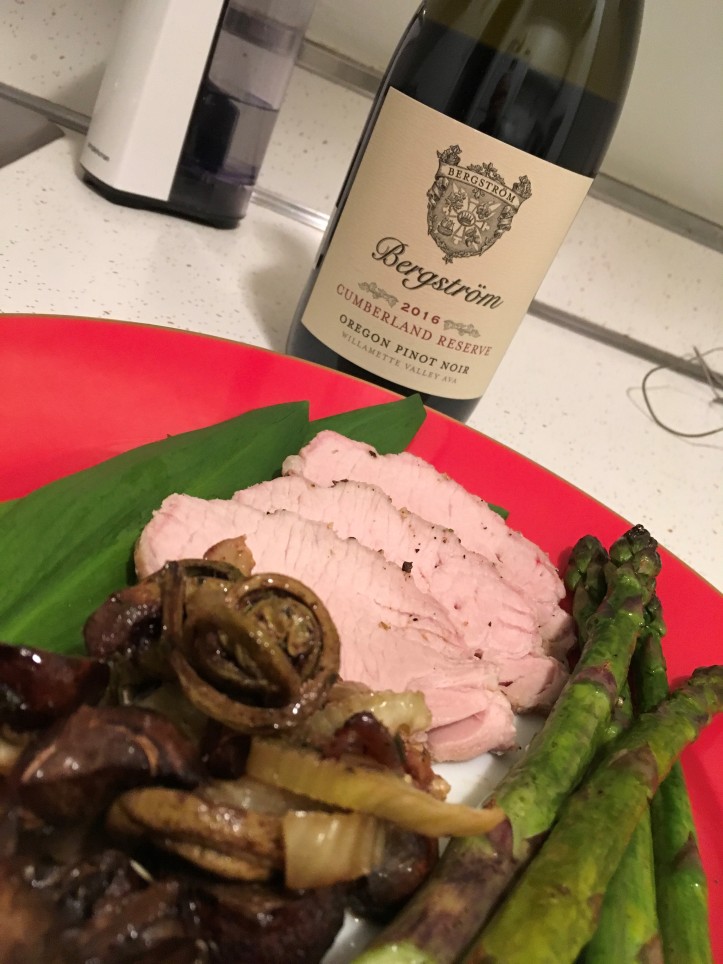
If it seems as though we wine bloggers have biodynamics on the brain these days, well, we do! Just like the rest of you consumers, we’re becoming more informed about what we eat and drink. We want to know how crops are grown, animals are raised, and vines are tended – because our buying decisions influence our health and have an impact on Mother Earth.
Last month the Wine Pairing Weekend group chatted about biodynamics, in general, with each of us contributing a food and wine pairing that featured a wine produced according to the holistic methods first championed by Rudolf Steiner. This month we’ve narrowed our focus a little, setting our sights on the Willamette Valley of Oregon, home to many biodynamic wineries.
You might be wondering exactly what biodynamic winemaking entails, and how it differs from organic and/or sustainable farming. Fear not! Our intrepid host, Jade from Tasting Pour has covered all that and more in her invitation post for this month’s event. Give it a read and get up to speed!
Our chat takes place this Saturday, May 11th, at 11 am ET and you’re welcome to join the conversation. Simply follow #WinePW on Twitter to find us and be sure to add the hashtag to your tweets so we can welcome you. Here’s a sample of what each blogger will contribute to the chat:
- David of Cooking Chat has prepared “Salmon, Farro and Mushrooms with Winderlea Pinot Noir”
- Camilla of Culinary Adventures with Camila is celebrating with “Simple Pleasures, A Birthday Cheeseboard, & Keeler Estate Vineyards’ 2017 Terracotta Amphorae Riesling“
- Jill of L’Occasion writes about “Peace, Bread, Land and Wine’: A Meal With Brooks Winery“
- Jennifer of Vino Travels will share “Biodynamic Wines of the Willamette Valley with King Estate“
- Lori of Dracaena Wines will present “Continuing the Biodynamic Legacy #WinePW“
- Jane from Always Ravenous pairs “Wild Alaskan Salmon with Herbed Ricotta and Oregon Pinot Noir”
- Pinny of Chinese Food and Wine Pairings combines “Biodynamic Grüner Veltliner and Pinot Noir from Johan Vineyards Plus Surf ‘n’ Turf Dinner”
- Linda of My Full Wine Glass shares “Ode to Oregon: Johan’s Biodynamic Expression of Place (#WinePW)”
- Gwendolyn Alley from Wine Predator will present “Our land is our life and our life is our wine” — Cooper Mountain Pinot Paired with Duck #WinePW
- Deana from Asian Test Kitchen has whipped up “Oregon Orange Wine Sparkles with Indian Curry”
- Wendy Klik A Day in the Life on the Farm discovers “Dammit!! These are some great wines from Willamette.
- Lauren Walsh of The Swirling Dervish will tempt us with “Pork Loin, Mushrooms, and Fiddlehead Ferns Meet Biodynamic Pinot Noir from Bergström Wines (#WinePW)”
- Martin of Enofylz Wine Blog brings us “A Taste of Cooper Mountain Vineyards at the Table #WinePW“
- Jeff of Food Wine Click is pairing “Biodynamic Willamette Valley with Brick House and Harissa Chicken”
- Payal of Keep the Peas is presenting “Living off the Land: King Estate Pinot Noir + Mushroom Pâté”
- Rupal of Syrah Queen is sharing “Maysara Winery – Iranian Immigrants Achieving The American Dream”
- Jade of Tasting Pour will share “Thai Green Curry Rockfish and Montinore Estate Gewurztraminer #WinePW”
- Nicole of Somm’s Table shares “A Hunt for a Biodynamic Williamette Valley Wine: Johan Vineyards Farmland Pinot Noir and Salmon“
John Bergström, founder of the winery, grew up in a small village 300 miles northwest of Stockholm, Sweden. His family home, part of a rustic logging community, had no electricity or telephone service. Self-sufficiency was the name of the game, and it brought the families together. Everyone who lived there became part of the logging trade; John himself took his first job at age 13.
Educational opportunities were scarce and when John’s aunt, who lived in Portland, Oregon, offered to let him live with her so he could attend high school, he jumped at the chance. After completing high school, he went on to college and then medical school, eventually establishing a surgical practice in Portland.

But his rural roots never left him. After marrying and having five children, John turned his attention to viticulture and winemaking, purchasing 13 acres of land in the Dundee Hills. Now, Bergström’s holdings include 84 acres devoted almost exclusively to Chardonnay and Pinot Noir. Five estate vineyards give rise to two Chardonnay offerings and nine Pinot Noirs.
Winemaking at Bergström is a family affair, with son Josh now at the helm. As a young man, he traveled his father’s route in reverse, leaving the Pacific Northwest to live in France and study wine. While there he met his wife, Caroline, who specializes in the business of wine. Today, Josh is the general manager, winemaker, and vineyard manager of the property, and Caroline oversees the sales and marketing components.

2016 Bergström Wines Cumberland Reserve Willamette Valley AVA Pinot Noir (13.8% abv; $42 at the winery)
Grapes for the Cumberland Reserve bottling come from the Bergström Vineyard, which sits atop ferrous red clay topsoils underpinned by dense volcanic rock. The vines, perched at 350-400 feet above sea level, enjoy both the sunny south-facing slopes and the cooling breezes that whisk through at night. It’s a hospitable place for agriculture, with hazelnuts, black walnuts, cane berries (e.g., raspberries and blackberries), mushrooms, and violets dotting the landscape. The entire property has been biodynamic for 12 years.
Bergström uses six Pinot Noir clones in this vineyard: Pommard; Wädenswil; and Dijons 114, 115, 667, and 777.

Cumberland Reserve was first made in 2001, making it the winery’s longest-running label. It’s also the hardest one to make, given the time required to sample (and re-sample) the contents of every barrel. And then there are the blending trials, tasting experiments designed to elicit the best from the grapes, given the growing season and the desired style of the finished wine. Josh believes the 2016 might be the best iteration of this label yet produced.
Some of the grapes undergo whole-cluster fermentation; the rest are destemmed first. The wine ages for 12 months in French oak barrels, 10% of which are new.
Color: Deep ruby, all the way to the rim.
Nose: Medium+ intensity aromas of violets, black cherry, thyme, and forest floor waft from the glass. It’s an invitation to abandon your cares, curl up on the couch, and contemplate becoming a winemaker.
Palate: It’s like the nose, but amped up: floral, herbal, ripe fruit, and mushrooms make for a whirlwind of sensory delight. There’s plenty of acidity, the tannins are smooth, and it is very well-balanced. The finish is long, with black cherry-berry fruit, just a hint of licorice, and garrigue. A pleasure to sip right now, this wine is only going to get better.

The Pairing: Herb-Roasted Pork Loin with Mushrooms and Fiddlehead Ferns
I just came back from New York City, where I enjoyed the arrival of bright green spring ingredients to the market. It reminded me of childhood, and big family dinners at my grandparents’ house. They had a vegetable garden out back, a small patch that would render sweet corn and tomatoes later in the summer. But those first treats each year, usually peas, scallions, and a few other things, were celebrated with more fanfare: their presence on the plate meant winter was over; time to turn our thoughts to summer and the long days ahead.
So, yeah, I went into the Whole Foods and bought everything fresh, vibrant, and fleeting: stinging nettles, ramp leaves, fiddlehead ferns, Jersey asparagus. I intended to gorge myself on all this greenness before I left New York. And my husband was going to eat everything I made, like it or not! (Click here to read about my other experiment!)
Lucky for him, this roast turned out perfectly!
And it was so simple to prepare:
- One pork loin (not tenderloin!) tied. Size is up to you – you can adapt everything.
- Fresh rosemary sprigs (maybe a dozen); don’t strip the needles.
- 12-18 fresh ramp leaves (if you can’t find them, omit.)
- Season the pork then slide the rosemary sprigs under the twine, side by side (you’re trying to create a layer that covers the whole roast lengthwise.)
- Drizzle with olive oil.
- If using the ramp leaves, place them over the rosemary sprigs, like you’re wrapping a present.
- Fold the ends under the roast, drizzle with olive oil.
- Add quartered baby portobello mushrooms, chopped red onion, and fiddlehead ferns around the roast. Season as you like.
- Bake at 325 degrees until internal temperature reaches 145. I use a thermometer whenever I cook pork loin – too easy to overdo it!)

The Verdict
It’s no secret that I love pork with Pinot Noir, and this dish didn’t disappoint. The meat was tender, with lovely herbal accents from the rosemary, and a little garlic-onion flavor from the ramp leaves. A spring-green dish made with the first crop from the garden!

Underneath, the mushrooms and fiddleheads combined to add an unctuous, earthy component to the dish that worked very well with the wine. All in all, a success!

Thanks for joining the Wine Pairing Weekend group for our study of biodynamic wines from the Willamette Valley. Have you tried a bottle you’d recommend? Please drop a comment below and tell me about it!
Cheers!
I love Pinot Noir with pork, especially roasted pork.
LikeLiked by 1 person
Thanks Wendy – it’s one of my favorite pairings, too.
LikeLike
[…] Lauren Walsh of The Swirling Dervish will tempt us with “Pork Loin, Mushrooms, and Fiddlehead Ferns Meet Biodynamic Pinot Noir from Bergström Wines (#WinePW… […]
LikeLike
[…] Lauren Walsh of The Swirling Dervish will tempt us with “Pork Loin, Mushrooms, and Fiddlehead Ferns Meet Biodynamic Pinot Noir from Bergström Wines (#WinePW… […]
LikeLike
I love the seasonal ingredients! Nice combination of flavors for pairing with pinot noir which indeed loves pork!!
LikeLiked by 1 person
Thank you! I had a blast rounding up the first greens of spring and putting them to use. Lots of creativity in the kitchen. 🙂
LikeLike
[…] Lauren Walsh of The Swirling Dervish will tempt us with “Pork Loin, Mushrooms, and Fiddlehead Ferns Meet Biodynamic Pinot Noir from Bergström Wines” […]
LikeLike
You should come out for a Pork and Pinot event some time. I have to admit I have never eaten a fiddlehead fern and I’m intrigued. Great wine choice and Josh is infinitely quotable.
LikeLiked by 1 person
Oh, I would love that! Pork and Pinot is a great match. This was my first time with both fiddlehead ferns and Bergstrom Pinot and I really enjoyed both.
LikeLike
[…] Lauren Walsh of The Swirling Dervish will tempt us with “Pork Loin, Mushrooms, and Fiddlehead Ferns Meet Biodynamic Pinot Noir from Bergström Wines” […]
LikeLike
Your pairing brings spring to the table! Stinging nettles, ramp leaves, fiddlehead ferns are so fresh from the season. Seems like the notes from this Bergström Pinot just go so well with the pork that’s infused by rosemary and ramp leaves!
LikeLiked by 1 person
All the ingredients really did work well with the wine. It was fun to cook with things that are in the market for just a short time!
LikeLike
Finding and cooking all those delightful spring greens is impressive by itself! Nice pairing with the pork too, as I do agree it pairs very well with Pinot.
LikeLiked by 1 person
Thanks! It was a fun experiment that turned out to be delicious. And the wine was a real treat!
LikeLike
I love this description!: “It’s an invitation to abandon your cares, curl up on the couch, and contemplate becoming a winemaker.” The pork also looks like a perfect paring, and I totally agree with your recommendation to always use a thermometer with pork loin — so easy to miss the sweet spot!
LikeLiked by 1 person
Thanks – it was inspired by the beautiful Bergstrom Pinot! The pairing turned out so well that I will definitely make it again.
LikeLike
[…] Lauren Walsh of The Swirling Dervish will tempt us with “Pork Loin, Mushrooms, and Fiddlehead Ferns Meet Biodynamic Pinot Noir from Bergström Wines (#WinePW… […]
LikeLike
Your grandparents garden sounds similar to the one I remember from my childhood. I would eat the peas as fast as I picked them. Looks like a tasty dish to celebrate spring and enjoy with an Oregon Pinot Noir!
LikeLiked by 1 person
Yes! The peas are never so sweet as when they’ve just been picked. I wish it were still so easy to find garden-fresh veggies.
LikeLike
The pork looks incredibly delicious! And I loved reading the story of returning to his roots… will definitely seek out Bergstrom wines.
LikeLike
This was the first Bergstrom wine I have tried and I loved it. I hope you have a chance to try one, too!
LikeLike
[…] Lauren Walsh of The Swirling Dervish will tempt us with “Pork Loin, Mushrooms, and Fiddlehead Ferns Meet Biodynamic Pinot Noir from Bergström Wines (#WinePW… […]
LikeLike
Pork roast shows off so many wines, right? This does seem like a crowd (or at least spouse) pleaser! Very nice!
LikeLiked by 1 person
It’s one of my go-to staples for wine pairing: you can dress it up with different herbs and spices, depending on which way you’re going. And it’s definitely easy to make for a crowd – as long as you’ve got a reliable meat thermometer. No one likes overcooked pork!
LikeLiked by 1 person
That’s a great looking pairing Lauren! And the Bergstrom wines sound wonderful. Will have to add to my “to visit” list for my next trip to Portland!
LikeLiked by 1 person
Thanks! It’s on my must-visit list too!
LikeLike
Oh, my goodness gracious! That is Spring deliciousness all on one plate. You had me at fiddlehead ferns though. Love your wine pairing, too.
LikeLiked by 1 person
Thanks! It was an experiment, to be sure, but it turned out pretty well.
LikeLike